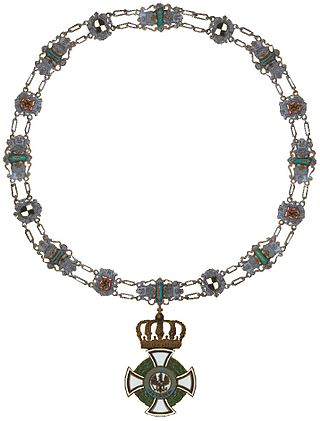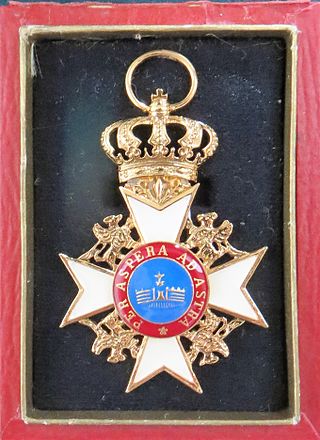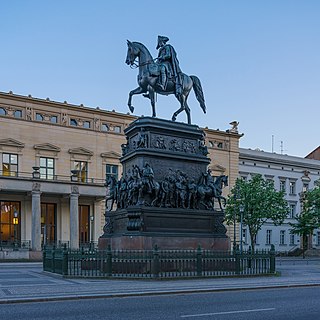Contents
This article needs additional citations for verification .(February 2020) |
| |||||
| Decades: | |||||
|---|---|---|---|---|---|
| See also: | Other events of 1861 History of Germany • Timeline • Years | ||||
Events from the year 1861 in Germany .
This article needs additional citations for verification .(February 2020) |
| |||||
| Decades: | |||||
|---|---|---|---|---|---|
| See also: | Other events of 1861 History of Germany • Timeline • Years | ||||
Events from the year 1861 in Germany .
The year 1861 in science and technology involved some significant events, listed below.

Archduke Franz Karl Joseph of Austria was a member of the House of Habsburg-Lorraine. He was the father of two emperors: Franz Joseph I of Austria and Maximilian I of Mexico. Through his third son Karl Ludwig, he was the grandfather of Archduke Franz Ferdinand of Austria – whose assassination sparked the hostilities that led to the outbreak of World War I.

The Order of the Black Eagle was the highest order of chivalry in the Kingdom of Prussia. The order was founded on 17 January 1701 by Elector Friedrich III of Brandenburg. In his Dutch exile after World War I, deposed Emperor Wilhelm II continued to award the order to his family. He made his second wife, Princess Hermine Reuss of Greiz, a Lady in the Order of the Black Eagle.

The House Order of Hohenzollern was a dynastic order of knighthood of the House of Hohenzollern awarded to military commissioned officers and civilians of comparable status. Associated with the various versions of the order were crosses and medals which could be awarded to lower-ranking soldiers and civilians.

The House and Merit Order of Duke Peter Frederick Louis or proper German Oldenburg House and Merit Order of Duke Peter Frederick Louis was a civil and military order of the Grand Duchy of Oldenburg, a member state of the German Empire. The order was founded by Grand Duke Augustus of Oldenburg on 27 November 1838, to honor his father, Peter Frederick Louis of Oldenburg. It became obsolete in 1918 after the abdication of the last grand duke.
Events from the year 1873 in Germany.

Prince Louis William Augustus of Baden was a Prussian general and politician. He was the father of Prince Maximilian of Baden, the last Minister President of the Kingdom of Prussia and last Chancellor of the German Empire. Wilhelm was a Prince of Baden, and a member of the House of Zähringen.

The House Order of Albert the Bear was founded in 1836 as a joint House Order by three dukes of Anhalt from separate branches of the family: Henry, Duke of Anhalt-Köthen, Leopold IV, Duke of Anhalt-Dessau, and Alexander Karl, Duke of Anhalt-Bernburg.
Events from the year 1880 in Germany.
Events in the year 1895 in Germany.
Events in the year 1877 in Germany.
Events from the year 1881 in Germany.
Events in the year 1882 in Germany.
Events in the year 1886 in Germany.

The House Order of the Wendish Crown is a dynastic order that was jointly instituted on 12 May 1864 by Grand Duke Friedrich Franz II of Mecklenburg-Schwerin and Grand Duke Friedrich Wilhelm of Mecklenburg-Strelitz. It is the oldest and most senior order of the House of Mecklenburg.
Heinrich Friedrich Franz Körte was a German natural and agricultural scientist, and for thirty years Professor of Natural Sciences at the Agricultural Academy in Möglin, which was founded by Albrecht Daniel Thaer.

The equestrian statue of Frederick the Great on Unter den Linden avenue in Berlin's Mitte district commemorates King Frederick II of Prussia. Created from 1839 to 1851 by Christian Daniel Rauch, it is a masterpiece of the Berlin school of sculpture, marking the transition from neoclassicism to realism. The bronze statue shows "The Old Fritz" dressed in military uniform, ermine coat and tricorne hat on horseback above the leading generals, statesmen, artists and scientist of his time. Walled in during World War II, it was disassembled by East Germany in 1950, reassembled in Sanssouci Park in 1963, and returned to its original location in 1980.

Friedrich Wilhelm Graf von Bismarck was a German lieutenant general, diplomat and military writer. He wrote several major military-political works and military histories, which were very pro-Napoleon.
Events from the year 1863 in Germany.
Events from the year 1848 in Germany.
Aus dem lithographischen Schiefer der Brüche von Solenhofen in Bayern ist mir in den beiden Gegenplatten eine auf der Ablösungs- oder Spaltungs-Fläche des Gesteins liegende Versteinerung mitgetheilt worden, die mit grosser Deutlichkeit eine Feder erkennen lässt, welche von den Vogel-Federn nicht zu unterscheiden ist. (From the lithographic slates of the faults of Solenhofen in Bavaria, there has been reported to me a fossil lying on the stone's surface of detachment or cleavage, in both opposing slabs, which can be recognized with great clarity [to be] a feather, which is indistinguishable from a bird's feather.)